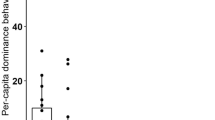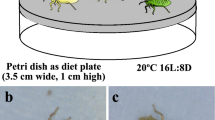Conclusions
It has been found that inZootermopsis nevadensis, a relatively primitive termite, the nymphs and older larvae carry out most nest-building behaviour, digging, and oscillatory movements. As they progress from young larvae to nymphs the termites tend to spend less time in trophallaxis and more time in other activities. The first instar nymphs and the sixth instar larvae are the most active in all respects. In terms of behaviour the sixth instar larvae are the nearest equivalent to a worker caste. Insects of the first nymphal instar can be roughly divided into those that spend much time in trophallaxis and relatively little in other activities andvice versa. This polarity was not evident in the younger insects.
The replacement reproductives spend most of their time in trophallaxis and very little in other activities. Most of this trophallaxis is with the younger larvae, while most of the trophallaxis of the other instars is with the replacement reproductives. It is suggested that behavioural differences such as those found here may be important in caste determination and regulation.
Résumé
On a trouvé que chezZootermopsis nevadensis, termite relativement primitif, ce sont les nymphes et les plus vieilles larves qui manifestent le plus un comportement constructeur et exécutent la plupart du terrassement et des mouvements oscillatoires. En évoluant de l'état de jeunes larves à celui de nymphes, les termites ont tendance à passer moins de temps en trophallaxie et plus à d'autres activités. Les nymphes du premier stade et les larves du sixième stade sont les plus actives à tous points de vue.
En termes de comportement, les larves du sixième stade sont l'équivalent le plus proche d'une caste d'ouvriers. Les nymphes du premier stade peuvent être, en gros, divisés en ceux qui passent beaucoup de temps en trophallaxie et relativement peu à d'autres activités et réciproquement. Cette polarité n'était pas évidente chez les insectes plus jeunes. Les sexués de remplacement passent la plupart de leur temps en trophallaxie et très peu à d'autres activités. La plus grande part de cette trophallaxie a lieu avec les plus jeunes larves, tandis que chez les autres stades elle a lieu avec les sexués de remplacement. Il est suggéré ici que les différences de comportement observées pourraient être importantes dans la détermination et la régulation des castes.
Similar content being viewed by others
References
Banks (N.) andSchneider (T. E.), 1920. — A revision of the nearctic termites.Bull. U.S. Nat. Mus.,108, p. 1–228.
Heath (H.), 1903. — The habits of California termites.Biol. Bull.,4, p. 47–63.—Heath (H.), 1927. Caste formation on the genusTermopsis. J. Morph.,43, p. 387–419.
Howse (P. E.), 1962. — Oscillation movements in the termiteZootermopsis angusticollis Emerson.Symposia Genetica et biol. it.,9, p. 256–268.—Howse (P. E.), 1964. The significance of the sound produced by the termiteZootermopsis angusticollis (Hagen).Anim. Behav.,12, p. 284–300.—Howse (P. E.), 1965. On the significance of certain oscillatory movements of termites.Insectes Sociaux,12, p. 335–346.
Schneirla (T. C.), 1952. — Basic correlations and coordinations in insect societies with special reference to ants.Colloques intern. Centre national Recher. sci.,34, p. 247–269.
Thompson (C. B.), 1922. — The castes ofTermopsis.J. Morph.,36, p. 495–535.
Verron (H.), 1963. — Role des stimuli chimiques dans l'attraction sociale chez «Calotermes flavicollis» (Fabr.).Thèse à la Faculté des Sciences de l'université de Paris. Masson et C1e.
Author information
Authors and Affiliations
Rights and permissions
About this article
Cite this article
Howse, P.E. On the division of labour in the primitive termiteZootermopsis nevadensis (Hagen). Ins. Soc 15, 45–50 (1968). https://doi.org/10.1007/BF02224893
Issue Date:
DOI: https://doi.org/10.1007/BF02224893




